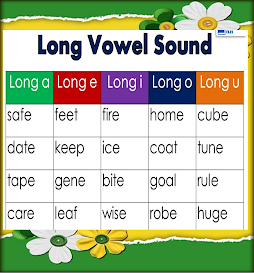Long vowel sounds are a type of vowel sound that is pronounced for a longer duration than short vowel sounds. In English, there are five vowel letters: A, E, I, O, and U. Each of these letters can represent both short and long vowel sounds.
A long vowel sound is usually produced by holding
the sound of the vowel for a longer period than usual. The long vowel sounds
are usually represented by a vowel followed by a silent "e" (such as
"cake," "kite," "note," "tube," and
"rule"), or by a vowel followed by another vowel (such as
"boat," "sheep," "rain," "beet," and
"soil").
The long vowel sound of "A" is
pronounced like the "A" in "cake," "gate," and
"face." This sound is made by positioning the tongue low and forward
in the mouth while opening the mouth wide.
The long vowel sound of "E" is
pronounced like the "E" in "beet," "see," and
"me." This sound is made by positioning the tongue high and forward
in the mouth while opening the mouth slightly.
The long vowel sound of "I" is
pronounced like the "I" in "kite," "ride," and
"time." This sound is made by positioning the tongue high and forward
in the mouth while opening the mouth wide.
The long vowel sound of "O" is
pronounced like the "O" in "note," "go," and
"home." This sound is made by positioning the tongue low and back in
the mouth while opening the mouth wide.
The long vowel sound of "U" is
pronounced like the "U" in "tube," "cute," and
"music." This sound is made by rounding the lips while positioning
the tongue high and back in the mouth.
It's important to note that long vowel sounds can
be tricky, especially for non-native English speakers. It's important to
practice and listen to examples of the correct pronunciation to improve your
skills.


No comments:
Post a Comment